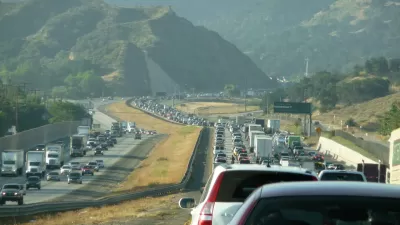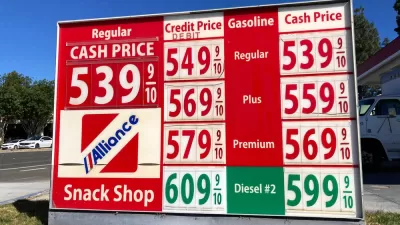Last year the U.S. Department of Transportation reported an increase of 3.3 percent in miles-traveled. During that same period, use of toll facilities, i.e., where motorists elect to pay to drive, increased 7.7 percent according to a new analysis.
"Motorists drove nearly 3.15 trillion miles last year – 3.5% or 107 billion miles more than 2014 – to clock in as the most heavily traveled year in U.S. history, according to the Federal Highway Administration (FHWA)," writes Bart Jansen for USA TODAY.
[See preliminary estimates in FHWA Traffic Volume Trends, December 2015 (PDF) and "So Much for Peak VMT" by Planetizen blogger Steven Polzin, director of mobility policy research at the Center for Urban Transportation Research at the University of South Florida.]
Another report shows that Americans are driving more, but in this case, it also shows their willingness to pay to do so.
"The number of trips driven on toll roads, bridges and tunnels rose 7%, according to a study [PDF] of 31 facilities by the International Bridge, Tunnel and Turnpike Association," writes Jansen. That's over twice the rate of increase in vehicle miles traveled (VMT) estimated by the FHWA. "The 5 billion trips through toll facilities surveyed represented 328 million more trips than 2014," adds Jansen.
"I think it shows that we have a very mobile, active workforce and people see value in using these toll facilities," Pat Jones, the association's CEO, told USA TODAY.
The five biggest gains were at the Tampa Hillsborough Expressway Authority in Florida (25%), North Carolina Department of Transportation (25%) [note expansion posed here], Central Texas Regional Mobility Authority in Austin (23.4%), Georgia’s State Road and Tollway Authority (19.6%) and Washington State Department of Transportation (16%).
But there's more to explaining the large uptick in the used of pay-to-drive facilities. Surprisingly, one of the same reasons that is prompting an increase in driving, namely the historically low gas prices, is causing people to seek less congested routes that offer time savings, according to a new analysis [PDF] from the International Bridge, Tunnel and Turnpike Association (IBTTA).
The 31 facilities that responded to the survey account for 80% of the tolls paid nationwide, collecting about $11 billion of $14 billion in tolls, Jones said. The survey found 23 facilities with record traffic and 10 with double-digit growth.
Not all is well in the industry though, particularly with toll roads owned or leased by private companies, e.g., the Texas State Highway (SH) 130 Toll Road. A November Planetizen post last year discusses the junk-bond status of the bonds issued by "SH 130 Concession Company, LLC, the private entity that designed, built, operates and maintains the southern sections of the SH 130 toll road," which on March 2 "filed for Chapter 11 protection" according to its website.
Patrick Fitzgerald, bankruptcy reporter for The Wall Street Journal, explains further in a May 2,2015 article about the emergence out of bankruptcy of the Indiana Toll Road.
Toll roads backed by private financing have struggled in recent years because of heavy debt burdens put in place on the assumption of rising traffic and toll revenue. American Roads LLC, which operates toll roads in Alabama and Michigan, restructured its debt in chapter 11 protection in 2013. The Australian operator of the Pocahontas 895 handed over the 8.8-mile toll road outside of Richmond, Va., to a group of its European creditors, also in 2013.
Note that the aforementioned five tolling organizations experiencing double digit growth are governmental entities.
Hat tip to AASHTO Journal
FULL STORY: USA Today: Growth in toll traffic outpaces regular roads — Mar 30

Maui's Vacation Rental Debate Turns Ugly
Verbal attacks, misinformation campaigns and fistfights plague a high-stakes debate to convert thousands of vacation rentals into long-term housing.

Planetizen Federal Action Tracker
A weekly monitor of how Trump’s orders and actions are impacting planners and planning in America.

In Urban Planning, AI Prompting Could be the New Design Thinking
Creativity has long been key to great urban design. What if we see AI as our new creative partner?

Florida Seniors Face Rising Homelessness Risk
High housing costs are pushing more seniors, many of them on a fixed income, into homelessness.

Massachusetts Budget Helps Close MBTA Budget Gap
The budget signed by Gov. Maura Healey includes $470 million in MBTA funding for the next fiscal year.

Milwaukee Launches Vision Zero Plan
Seven years after the city signed its Complete Streets Policy, the city is doubling down on its efforts to eliminate traffic deaths.
Urban Design for Planners 1: Software Tools
This six-course series explores essential urban design concepts using open source software and equips planners with the tools they need to participate fully in the urban design process.
Planning for Universal Design
Learn the tools for implementing Universal Design in planning regulations.
Gallatin County Department of Planning & Community Development
Heyer Gruel & Associates PA
JM Goldson LLC
City of Camden Redevelopment Agency
City of Astoria
Transportation Research & Education Center (TREC) at Portland State University
Jefferson Parish Government
Camden Redevelopment Agency
City of Claremont





























